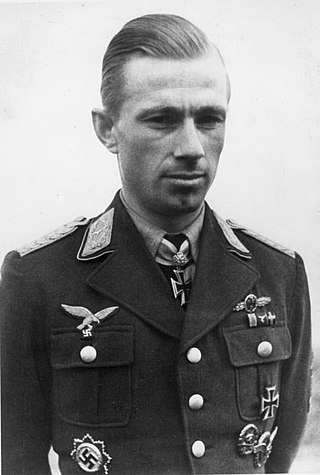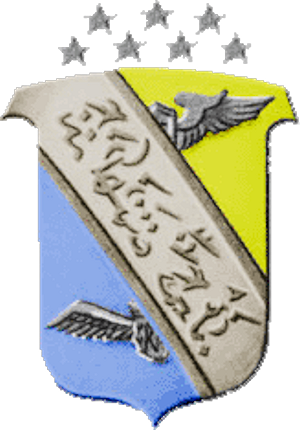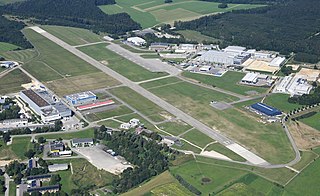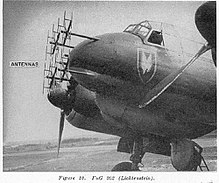
Helmut Lent was a German night-fighter ace in World War II. Lent shot down 110 aircraft, 102 of them at night. Born into a devoutly religious family, he showed an early passion for glider flying; against his father's wishes, he joined the Luftwaffe in 1936. After completing his training, he was assigned to the 1. Squadron, or Staffel, of Zerstörergeschwader 76 (ZG 76), a wing flying the Messerschmitt Bf 110 twin-engine heavy fighter. Lent claimed his first aerial victories at the outset of World War II in the invasion of Poland and over the North Sea. During the invasion of Norway he flew ground support missions before he was transferred to the newly established Nachtjagdgeschwader 1 (NJG 1), a night-fighter wing.

Lucius D. Clay Kaserne, commonly known as Clay Kaserne, formerly known as Wiesbaden Air Base and later as Wiesbaden Army Airfield, is an installation of the United States Army in Hesse, Germany. The kaserne is located within Wiesbaden-Erbenheim. Named for General Lucius D. Clay, it is the home of the Army's 2d Theater Signal Brigade, 66th Military Intelligence Brigade and is the headquarters of the U.S. Army Europe and Africa (USAREUR-AF).
Beauvechain Air Base is a Belgian Air Component military airfield in Belgium, located 3 nautical miles south of Beauvechain in Wallonia ; 20 mi (32 km) east-southeast of Brussels.

Roth Air Base is located 4 kilometres (2.5 mi) south of the city of Roth in Bavaria, Germany.

The 350th Fighter Group was an air combat unit of the United States Army Air Force formed in 1942 and inactivated in 1945. The fighter group consisted of 345th, 346th and 347th Fighter Squadron. The group was formed in England in 1942 flying Bell P-39 Airacobras and participated in the Mediterranean and North African Campaigns of World War II. 350th Fighter Group was based in North Africa, in Algeria and Morocco from January to July 1943. They then moved on to the Mediterranean islands of Sardinia and Corsica in November 1943 and February 1944 and were based in Italy from September 1944 to July 1945. After the group was inactivated on 7 November 1945 at Seymour Johnson Air Force Base following the end of the war. It was redesignated the 112th Fighter Group and placed under the control of the Pennsylvania Air National Guard in 1946.
Saint-Dizier-Robinson Air Base is a front-line French Air and Space Force fighter aircraft base located approximately 4 km west of Saint-Dizier, in the Haute-Marne department of the Champagne-Ardenne region in northeastern France.

Brétigny-sur-Orge Air Base is a former French Air Force French: Armée de l'Air (ALA) base. The base is located approximately 2 miles (3.2 km) southeast of Brétigny-sur-Orge; about 17 miles (27 km) south of Paris.
Juvincourt Airfield is an abandoned military airfield, which is located near the commune of Juvincourt-et-Damary in the Aisne department of northern France.
Sint-Truiden / Brustem Airfield is an airfield located in Brustem, 1.5 nautical miles southeast of Sint-Truiden (Limburg) and approximately 37 mi (60 km) east of Brussels. Formerly known as Sint-Truiden Air Base or Brustem Air Base, the aerodrome was deactivated as a Belgian Air Component base in 1996.

Metz-Frescaty Air Base was a front-line French Air Force French: Armée de l'Air (ALA) base. The base is located approximately 5 miles (8.0 km) south-southwest of Metz, about 174 miles (280 km) east of Paris.

Griesheim Airport is a private airfield in Germany, located 1-mile (1.6 km) southwest of Griesheim (Hessen); approximately 270 miles (430 km) southwest of Berlin.
Biblis Airfield is an abandoned World War II military airfield located in Germany, approximately 5 miles northeast of Worms (Rheinland-Pfalz); approximately 300 miles southwest of Berlin.
Münster-Handorf Airfield is a former military airfield located in Germany about 5 miles east-northeast of Münster (Nordrhein-Westfalen); approximately 250 miles west of Berlin.

Lippstadt Airfield is a former military airfield located in Germany, located in the northern part of Lippstadt (Nordrhein-Westfalen); approximately 222 miles (357 km) west-southwest of Berlin.

Katterbach Kaserne is a United States Army facility in Germany, located in the village of Katterbach, about 3 miles east-northeast of Ansbach (Bavaria); about 250 miles south-southwest of Berlin.

Storck Barracks/Illesheim Kaserne is a United States Army facility adjacent to Illesheim, Germany, located about 15 miles northwest of Ansbach (Bavaria), about 240 miles south-southwest of Berlin.
Harvey Barracks/Kitzingen Army Airfield is a former United States Army 3rd Infantry Division facility in Germany, located about 3,5 km east-northeast of Kitzingen (Bavaria), about 390 km southwest of Berlin and 202 km north-northwest of Munich.

Kassel-Rothwesten Airfield is a former military airfield located in Rothwesten, a part of Fuldatal in Germany about 5 miles (8.0 km) north-northeast of Kassel (Hessen); approximately 240 miles (390 km) southwest of Berlin.
Saint-André-de-l'Eure Airfield is a recreational aerodrome in France, located about 10 miles southwest of Évreux (Normandy). It supports general aviation with no commercial airline service scheduled.

Neuhausen ob Eck Airfield is a special airfield near the town of Neuhausen ob Eck in the district of Tuttlingen in Baden-Württemberg, Southern Germany. Used as a military airbase by the German Army Aviation Corps until 1994, it was rededicated a special airfield, and is since 1997 the site of the business park take-off GewerbePark Betreibergesellschaft mbH. Since 2002, the airfield also hosts the annual Southside Music Festival.
















